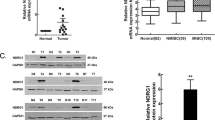Abstract
Ubiquitin-like with PHD and ring finger domains 1 (UHRF1) is a novel anti-apoptotic gene, and overexpression of UHRF1 is involved in tumorigenicity. Here, immunohistochemistry was used to detect UHRF1 expression in non-muscle-invasive bladder cancer (NMIBC), and these data were examined for correlation with clinicopathological parameters and prognosis. The UHRF1 expression rate was 49.2% in a total of 118 bladder cancer tissues, which was significantly higher than in normal tissues, and UHRF1 expression has a significantly positive correlation with tumor grade (P = 0.027) and recurrence (P = 0.013). Survival analysis showed that UHRF1 high expression patients’ mean survival time (42.59 months) was significantly shorter than that (71.36 months) of UHRF1 low expression patients (P = 0.0002). Multivariate analysis showed that UHRF1 overexpression was an independent prognostic factor for tumor recurrence (P < 0.0001). So UHRF1 may be a molecular marker to predict the recurrence of NMIBC.


Similar content being viewed by others
References
Jemal A, Siegel R, Ward E, et al. Cancer statistics, 2009. CA Cancer J Clin. 2009;59(4):225–49.
Kaufman DS, Shipley WU, Feldman AS. Bladder cancer. Lancet. 2009;374(9685):239–49.
Reuter VE. Bladder. risk and prognostic factors—a pathologist’s perspective. Urol Clin North Am. 1999;26(3):481–92.
Millan-Rodriguez F, Chechile-Toniolo G, Salvador-Bayarri J, et al. Multivariate analysis of the prognostic factors of primary superficial bladder cancer. J Urol. 2000;163(1):73–8.
Muto M, Utsuyama M, Horiguchi T, et al. The characterization of the monoclonal antibody Th-10a, specific for a nuclear protein appearing in the S phase of the cell cycle in normal thymocytes and its unregulated expression in lymphoma cell lines. Cell Prolif. 1995;28(12):645–57.
Fujimori A, Matsuda Y, Takemoto Y, et al. Cloning and map** of Np95 gene which encodes a novel nuclear protein associated with cell proliferation. Mamm Genome. 1998;9(12):1032–5.
Uemura T, Kubo E, Kanari Y, et al. Temporal and spatial localization of novel nuclear protein NP95 in mitotic and meiotic cells. Cell Struct Funct. 2000;25(3):149–59.
Arima Y, Hirota T, Bronner C, et al. Down-regulation of nuclear protein ICBP90 by p53/p21Cip1/WAF1-dependent DNA-damage checkpoint signals contributes to cell cycle arrest at G1/S transition. Genes Cells. 2004;9(2):131–42.
Bonapace IM, Latella L, Papait R, et al. Np95 is regulated by E1A during mitotic reactivation of terminally differentiated cells and is essential for S phase entry. J Cell Biol. 2002;157(6):909–14.
Papait R, Pistore C, Negri D, et al. Np95 is implicated in pericentromeric heterochromatin replication and in major satellite silencing. Mol Biol Cell. 2007;18(3):1098–106.
Bostick M, Kim JK, Esteve PO, et al. UHRF1 plays a role in maintaining DNA methylation in mammalian cells. Science. 2007;317(5845):1760–4.
Sharif J, Muto M, Takebayashi S, et al. The SRA protein Np95 mediates epigenetic inheritance by recruiting Dnmt1 to methylated DNA. Nature. 2007;450(7171):908–12.
Arita K, Ariyoshi M, Tochio H, et al. Recognition of hemi-methylated DNA by the SRA protein UHRF1 by a base-flip** mechanism. Nature. 2008;455(7214):818–21.
Avvakumov GV, Walker JR, Xue S, et al. Structural basis for recognition of hemi-methylated DNA by the SRA domain of human UHRF1. Nature. 2008;455(7214):822–5.
Qian C, Li S, Jakoncic J, et al. Structure and hemimethylated CpG binding of the SRA domain from human UHRF1. J Biol Chem. 2008;283(50):34490–4.
Achour M, Jacq X, Ronde P, et al. The interaction of the SRA domain of ICBP90 with a novel domain of DNMT1 is involved in the regulation of VEGF gene expression. Oncogene. 2008;27(15):2187–97.
Jeanblanc M, Mousli M, Hopfner R, et al. The retinoblastoma gene and its product are targeted by ICBP90: a key mechanism in the G1/S transition during the cell cycle. Oncogene. 2005;24(49):7337–45.
Hopfner R, Mousli M, Jeltsch JM, et al. ICBP90, a novel human CCAAT binding protein, involved in the regulation of topoisomerase II alpha expression. Cancer Res. 2000;60(1):121–8.
Mousli M, Hopfner R, Abbady AQ, et al. ICBP90 belongs to a new family of proteins with an expression that is deregulated in cancer cells. Br J Cancer. 2003;89(1):120–7.
Unoki M, Nishidate T, Nakamura Y. ICBP90, an E2F–1 target, recruits HDAC1 and binds to methyl-CpG through its SRA domain. Oncogene. 2004;23(46):7601–10.
Crnogorac-Jurcevic T, Gangeswaran R, Bhakta V, et al. Proteomic analysis of chronic pancreatitis and pancreatic adenocarcinoma. Gastroenterology. 2005;129(5):1454–63.
Lorenzato M, Caudroy S, Bronner C, et al. Cell cycle and/or proliferation markers: what is the best method to discriminate cervical high-grade lesions? Hum Pathol. 2005;36(10):1101–7.
Unoki M, Kelly JD, Neal DE, et al. UHRF1 is a novel molecular marker for diagnosis and the prognosis of bladder cancer. Br J Cancer. 2009;101(1):98–105.
Jenkins Y, Markovtsov V, Lang W, et al. Critical role of the ubiquitin ligase activity of UHRF1, a nuclear RING finger protein, in tumor cell growth. Mol Biol Cell. 2005;16(12):5621–9.
Bronner C, Achour M, Arima Y, et al. The UHRF family: oncogenes that are drugable targets for cancer therapy in the near future? Pharmacol Ther. 2007;115(3):419–34.
Hussain SP, Harris CC. Molecular epidemiology and carcinogenesis: endogenous and exogenous carcinogens. Mutat Res. 2000;462(2–3):311–22.
Abbady AQ, Bronner C, Trotzier MA, et al. ICBP90 expression is downregulated in apoptosis-induced Jurkat cells. Ann N Y Acad Sci. 2003;1010:300–3.
Theodoropoulos VE, Lazaris AC, Kastriotis I, et al. Evaluation of hypoxia-inducible factor 1alpha overexpression as a predictor of tumour recurrence and progression in superficial urothelial bladder carcinoma. BJU Int. 2005;95(3):425–31.
Dekairelle AF, Tombal B, Cosyns JP, Gala JL. Assessment of the transcriptional activity of p53 improves the prediction of recurrence in superficial transitional cell carcinoma of the bladder. Clin Cancer Res. 2005;11(13):4724–32.
Conflict of interest
There is no conflict of interest.
Author information
Authors and Affiliations
Corresponding author
Rights and permissions
About this article
Cite this article
Yang, GL., Zhang, LH., Bo, JJ. et al. UHRF1 is associated with tumor recurrence in non-muscle-invasive bladder cancer. Med Oncol 29, 842–847 (2012). https://doi.org/10.1007/s12032-011-9983-z
Received:
Accepted:
Published:
Issue Date:
DOI: https://doi.org/10.1007/s12032-011-9983-z




